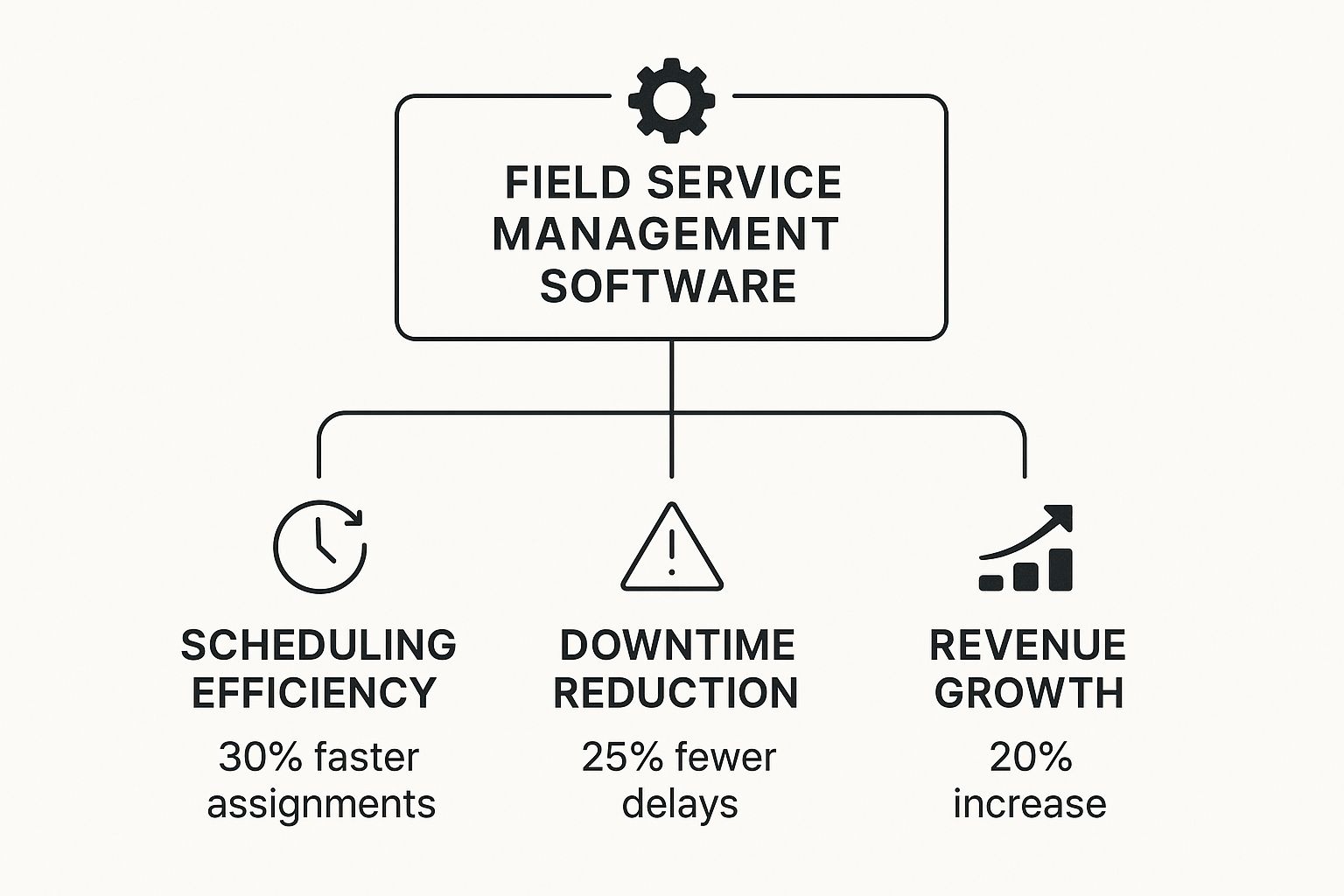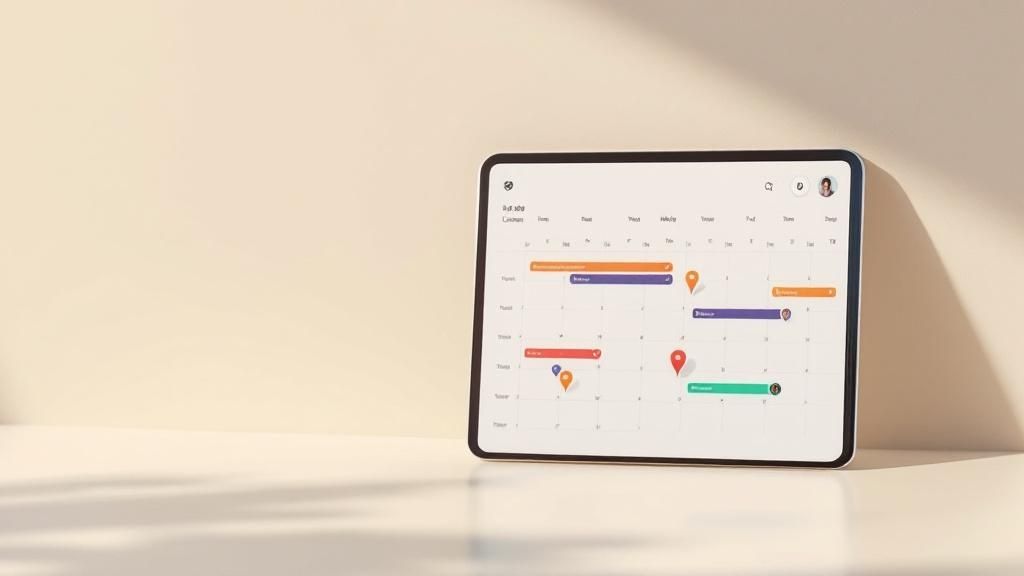Staring at a chaotic scheduling board or digging through stacks of paper invoices? If you run an HVAC company, that scene might feel all too familiar. Trying to manage your business with manual methods is a lot like trying to navigate a busy city without a map—you'll get there eventually, but not without wasting a ton of fuel, time, and sanity.
Why HVAC Software Is No Longer Optional for Growth

The days of treating specialized software as some kind of "nice-to-have" luxury are long gone. For any HVAC business that wants to grow, dedicated field service management (FSM) software is now an essential part of the toolkit. The hidden costs of disorganized dispatching, missed appointments, and sluggish invoicing pile up fast, holding your business back. A central platform is really the only effective solution to these persistent operational headaches.
This isn't just a feeling; the numbers tell the same story. The global market for HVAC field service software was valued at around USD 1.5 billion in 2023. It’s projected to more than double to USD 3.2 billion by 2032. That’s a compound annual growth rate (CAGR) of 8.7%, fueled by businesses scrambling for better operational control and customers demanding better service. You can dig into the market growth specifics on DataIntelo.
The True Cost of Inefficiency
Relying on pen, paper, and spreadsheets creates friction at every single touchpoint. A simple scheduling mistake can send a technician driving clear across town for a routine maintenance call, burning expensive gas while an emergency AC-out job sits waiting. A misplaced invoice can easily delay payment by weeks, putting a serious strain on your cash flow.
These aren't just minor annoyances. They're fundamental problems that actively prevent your business from scaling up.
Think of it this way: Every hour a technician spends doing paperwork, driving an inefficient route, or calling the office for information is an hour they aren't generating revenue. FSM software is designed to give that time back.
Paving the Way for Smart Operations
Bringing in a field service management platform is about so much more than just going paperless. It's about completely re-engineering your daily operations to work smarter, not harder. It gives your team the tools to do what they do best, only better.
- Optimize every route to squeeze more profitable jobs into each day.
- Automate customer communications, sending everything from appointment reminders to "technician on the way" texts.
- Give technicians instant access to customer history, equipment manuals, and checklists right on their tablet.
- Generate and send professional invoices right from the job site, getting you paid faster.
This guide will walk you through everything you need to know to find the right software, delight your customers, and build a more resilient HVAC business.
The 7 Core Features Your HVAC Business Can't Ignore
When you’re looking for the right field service management (FSM) software for your HVAC company, it's easy to get lost in endless feature lists. The secret isn't finding the platform with the most features; it's about identifying the tools that solve your biggest, most expensive headaches.
Think of it like loading a tech’s van. You have the essential wrenches, gauges, and meters they need for every single call. Then you have the specialized diagnostic equipment for those tricky, less common problems. You should approach your software the same way: start with a solid foundation of core functions you simply can’t operate without.
1. Intelligent Scheduling and Dispatching
A messy, disorganized schedule is a direct hit to your bottom line. Intelligent scheduling and dispatching is the digital command center that finally brings order to the chaos. This is so much more than just a shared calendar. A modern system acts like your most experienced dispatcher, looking at technician skills, their real-time location via GPS, and even local traffic to make the smartest job assignment.
This means you’ll stop sending your senior commercial RTU specialist to a simple residential filter change halfway across town. The result? A serious drop in fuel costs, less wasted time behind the windshield, and more billable hours packed into every technician's day.
2. A Powerful Technician Mobile App
Your technicians are the face of your company, and their on-site efficiency is everything. A top-notch mobile app puts every scrap of information they could possibly need right in the palm of their hand. Honestly, this is the single most important tool for killing return trips and ditching the mountain of paperwork.
A great mobile app doesn't just show information; it empowers your techs to get the job done right, the first time. When a technician can pull up a customer's complete service history, follow a digital checklist for a tricky diagnostic, and take a credit card payment on the spot, you've turned them from a simple wrench-turner into a true service professional.
These core software benefits directly fuel business growth, as this graphic shows.

As you can see, the efficiency you gain from better scheduling and field operations leads directly to less downtime and a real boost in revenue.
3. Integrated CRM
A Customer Relationship Management (CRM) tool that’s built right into your FSM software gives everyone in the office a complete 360-degree view of every client. No more digging through different files or spreadsheets.
This means your office staff can instantly see past quotes, active service agreements, and all communication history. It allows for smarter, more personalized service that makes customers feel valued.
4. Real-Time Inventory Tracking
"I have to run back to the shop" are words that make every customer cringe. Real-time inventory tracking tells you exactly what parts are on which truck, at all times.
This feature stops a technician from showing up to a job only to find out they don't have the right capacitor. It saves a second trip, keeps the customer happy, and makes your entire operation look more professional.
5. Automated Invoicing and Quoting
The faster you bill, the faster you get paid. It's that simple. With automated invoicing, the moment a job is marked 'complete' on the tech’s mobile app, the system can instantly generate and email a professional invoice to the customer. No more waiting for paperwork to get back to the office.
The same goes for quoting. Your techs can build accurate, multi-option quotes right on their tablet and get customer approval before they even leave the driveway. This simple automation dramatically improves cash flow, shrinking the payment cycle from weeks down to days, or even minutes.
Essential vs. Advanced HVAC Software Features
As you evaluate different platforms, it’s helpful to understand the difference between the foundational tools every HVAC shop needs and the more advanced features that help you scale. Think of it as "must-haves" for today versus "good-to-haves" for tomorrow's growth.
These essential features are the bedrock of a well-run operation, while the advanced ones provide the leverage you need to expand your team and service area without chaos.
6. Robust Reporting and Analytics
You can't improve what you don't measure. Solid reporting tools take all the data flowing through your system—from job times and parts usage to sales metrics—and turn it into easy-to-understand dashboards.
This is how you spot your most profitable job types, identify which technicians are the most efficient, and track key performance indicators (KPIs) like first-time fix rates. It’s like having an X-ray of your business's health.
7. Service Agreement Management
Recurring revenue from maintenance contracts is the lifeblood of a stable HVAC business. Service agreement management tools automate the entire process. The software tracks contract terms, schedules preventative maintenance visits automatically, and handles recurring billing without any manual effort.
This ensures no tune-ups are missed, keeps your customers happy and loyal, and provides a predictable stream of income, especially during the slower shoulder seasons. It’s a critical feature for building long-term business value.
The market for these tools is exploding for a reason: the ROI is undeniable. Projections show the HVAC software market will surge from $737.7 million in 2025 to $1.53 billion by 2035. You can learn more about these HVAC software market trends on Future Market Insights. These seven core features are the engine driving that incredible growth.
Turning Software Features into Real-World Profits

It’s one thing to see a long list of software features, but it's another to understand how a digital calendar or a mobile app actually puts more money in your pocket. So, let’s connect the dots and see how the tools in field service management software for hvac create real-world profits.
The most direct path to higher revenue is simply doing more with the time you have. Think about technician routing. It’s not just about shaving a few dollars off your gas bill; it’s about opening up more slots for paying jobs.
Good software analyzes your tech’s location, their specific skills, and even live traffic to help you fit more appointments into a single day. Squeezing in just one extra service call per tech each week adds up to a significant revenue bump by the end of the year. That’s not a small tweak—it’s a change that fundamentally boosts your earning potential.
Fostering Unshakeable Customer Loyalty
In the HVAC world, trust is everything. Software features are built to earn that trust and keep it, turning a one-time emergency call into a loyal customer with a profitable service agreement. Something as simple as an automated service reminder shows you're looking out for their system's health, not just waiting for it to break.
Imagine a customer getting a text with a GPS link showing their tech is 15 minutes away. That single feature replaces the old, frustrating "we'll be there between 8 and 4" window with genuine respect for their time. It makes your company look incredibly professional and reliable.
A complete, accessible digital service history is another powerful tool. When a customer knows you have a detailed record of every repair, tune-up, and part replacement, it builds unshakable confidence in your expertise, leading directly to five-star reviews and repeat business.
Accelerating Your Cash Flow
Nothing can strangle a healthy HVAC business faster than slow payments. That gap between finishing the work and seeing the money in your bank account is a major headache. Modern software attacks this problem from every angle.
Here’s how a good FSM platform can completely change your cash flow cycle:
- On-Site Invoicing: The moment a job is done, your tech can generate and email a professional, itemized invoice right from their tablet. No more lost paperwork or back-office delays.
- Instant Digital Payments: With a mobile app and a card reader, technicians can accept credit card or bank payments on the spot. This simple step can shrink your payment timeline from weeks to just a few minutes.
This immediate payment cycle gives you the financial breathing room to invest in new equipment, hire more techs, and manage daily expenses without constantly waiting for checks to clear. It’s all about making your money work for you, right away.
Future-Proof Your Business with IoT and Smart Tech
The next big step forward in HVAC service isn’t about working harder—it's about knowing what your client needs before they even know there's a problem. The entire industry is moving from being reactive to proactive, and this change is happening because we can now connect field service management software for hvac with smart technology. This is where the Internet of Things, or IoT, really shines.
So, what does that actually look like? Picture a client's big commercial rooftop unit. Now, imagine we attach a small, smart sensor to it. This little device is constantly watching key performance stats like temperature, pressure, and how much energy it's using. It's like having a tiny technician on-site 24/7, just keeping an eye on things.
From Reactive Repairs to Predictive Maintenance
When that sensor notices the unit's performance is starting to slip, even just a little, it doesn't wait for the whole thing to break down. Instead, it instantly shoots an alert straight to your FSM software. This isn't some vague warning, either—it’s packed with specific data that points to the likely issue, like an inefficient compressor or a filter that's getting clogged.
Your dispatch team sees the alert and can schedule a maintenance visit right away. You're no longer scrambling to respond to a frantic emergency call about a dead unit. You're getting ahead of the problem before it becomes a crisis. That completely changes the game.
This simple shift turns a low-margin, high-stress emergency call into a planned, high-value service visit. You get to control the schedule, your tech shows up with the right parts already in the truck, and the customer starts seeing you as a true partner in keeping their system reliable and efficient.
Building New Revenue with Smart Technology
This predictive approach does more than just stop breakdowns; it opens up some fantastic new ways to make money. By offering IoT monitoring, you can create premium service agreements that are incredibly valuable to your clients, especially commercial customers who can’t afford any downtime. These contracts bring in steady, predictable income that helps smooth out your cash flow all year long.
And this isn't just a niche idea—the market is sprinting in this direction. The push for sustainability and the obvious ROI from predictive data are driving massive growth. In fact, the global IoT in HVAC market is expected to hit $14.4 billion by 2025. This surge is directly boosting demand for software that can interpret all this real-time information. You can dig deeper into this trend and its effect on the HVAC service software market.
When you bring these tools into your business, you’re no longer just a repair service. You become a leader in energy management and operational performance. It’s how you stay ahead of the curve and prove to clients that you offer the most advanced, reliable service on the market.
How to Choose the Right HVAC Software

With so many options out there for field service management software for hvac, it's easy to feel like you're drowning in choices. I get it. Picking a platform is a huge decision, but it doesn't have to be a headache. Let's walk through a straightforward way to find the right software partner for your business.
The secret is to work from the inside out. Don't let a salesperson dazzle you with slick features you'll never touch. The best starting point is always your own operation and the problems you need to solve right now.
Audit Your Current Operations
Before you even think about scheduling a demo, take a long, honest look at how you're running things today. Where do things get stuck? What simple tasks eat up way too much time for your office staff or your techs in the field?
Jot down a list of your biggest headaches. Is scheduling a constant mess of phone calls and texts? Are invoices getting sent out weeks late? Maybe you're tired of hounding technicians for handwritten job notes you can barely read. When you pinpoint these frustrations, you create a clear checklist of what any new software absolutely must fix. This first step is everything; it stops you from buying a high-powered tool for a problem you don't even have.
Prioritize Your Feature Wishlist
Now that you know what's broken, you can start looking for the fixes. It's time to build a feature wishlist, but let's be strategic about it. Split your list into two simple categories: must-haves and nice-to-haves.
- Must-Haves: These are your deal-breakers. They're the features that directly attack the pain points you just uncovered. If slow payments are killing your cash flow, then features like on-the-spot payment processing and automated invoice reminders are non-negotiable.
- Nice-to-Haves: These are the "would be great if..." features. They're valuable but not essential for solving your immediate problems. Think advanced analytics dashboards or a self-service customer portal.
Keeping your list prioritized this way will keep you grounded during demos. And as you consider your needs, it helps to understand what's possible. Looking at guides for things like the best free CRM tools for SMBs can give you a good baseline for what to expect from modern customer management features.
I see it all the time: a 10-person shop paying for a feature suite built for a 100-person enterprise. Your software needs to fit your business as it is today, but it should also give you a clear path to grow into tomorrow.
Plan for Growth and Usability
The software you pick now should be able to keep up as your business expands. When you talk to vendors, ask them point-blank how their platform scales. What happens when you double your team? Do they have sensible pricing tiers, or are you going to get hit with a massive bill the moment you add a few more trucks?
Finally, and this might be the most important part, the software has to be easy to use. The most feature-packed tool in the world is completely worthless if your team hates it and won't use it. The mobile app needs to be so simple that your least tech-savvy technician can pick it up and run with it. Whenever possible, sign up for a free trial and get your team in on the action. Their feedback is gold, and their buy-in is the only thing that guarantees you’ll get your money's worth.
Still Have Questions About HVAC Software?
Making the leap to new software is a big decision. It’s not just another tool; it's a new way of running your entire business. So, it's completely normal to have a few questions rolling around in your head. Let's walk through some of the most common ones we hear from HVAC owners just like you.
My aim here is to cut through the jargon and give you practical answers you can actually use. We'll look at the real-world concerns—cost, setup time, and getting your crew on board—so you can feel confident about your next steps.
How Long Does This Take to Get Up and Running?
The thought of a long, disruptive software setup is enough to give any owner a headache. But here’s the good news: for most small to mid-sized HVAC shops, we’re talking days or weeks, not months. The whole process is probably faster than you're imagining.
A good software partner won't just hand you the keys and walk away. They’ll have a clear, step-by-step plan to get you started. This usually involves:
- Data Migration: They’ll help you pull all your existing customer info, service histories, and price books into the new system. No more manual entry.
- System Configuration: This is where you make it your own. You’ll customize things like job types, maintenance checklists, and invoice branding to fit how you already do business.
- Team Training: They'll host training sessions for your office staff and your field techs, making sure everyone knows their way around the new tools from day one.
The secret to a painless switch is pretty simple. First, pick a software provider that has a reputation for great customer support. Second, block out a little time for your team to really learn the ropes. That small investment of time upfront pays for itself almost instantly.
Is This Actually Affordable for a Small Business?
Yes, it absolutely is. The days of needing a massive, five-figure check just to get started are long gone. Today, nearly all field service software is sold as a Software-as-a-Service (SaaS) subscription.
Think of it like Netflix for your business. You pay a predictable monthly fee, usually based on how many technicians you have on the road. This model turns what used to be a huge capital investment into a simple, manageable operating cost, making powerful tools accessible to everyone.
When you're looking at the price tag, don't forget to think about the return. If the software helps you squeeze in just one more high-profit job a month or prevents a single costly scheduling mistake, it's often already paid for itself. Most companies offer different pricing tiers, so you can start with what you need now and add more features as you grow.
Will My Techs Even Bother Using the App?
This is the big one, isn't it? A fancy software platform is worthless if the people in the field won't use it. The best software designers get this. They know that a clunky mobile app is a useless one.
You want an app that was clearly built for technicians, not office managers. Look for big, easy-to-tap buttons, simple menus, and a flow that makes sense for someone working in a customer's home. A great app makes a tech’s job easier—it gets rid of paperwork and puts all the information they need right at their fingertips, instead of adding another headache to their day.
The best way to know for sure? Let your team try it. Before you sign anything, get your best (and maybe your most skeptical) tech to test drive the mobile app. Their honest feedback is gold. And make sure it has critical features like offline functionality, so they can keep working in a basement or a rural area with spotty service. When the app helps them get their work done faster and with fewer mistakes, they won't just use it—they'll wonder how they ever worked without it.
Ready to eliminate manual note-taking and streamline communication between your field and office teams? Discover how Nora uses the power of AI and WhatsApp to capture clean, accurate job notes instantly. Book a demo of Nora today!



